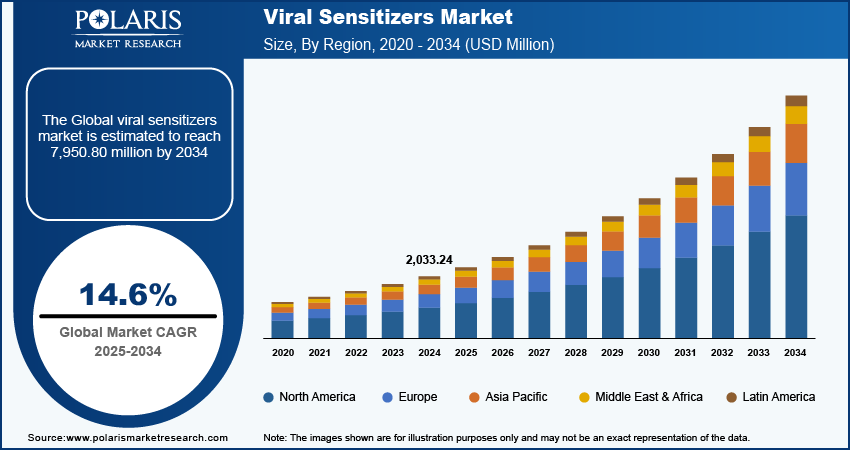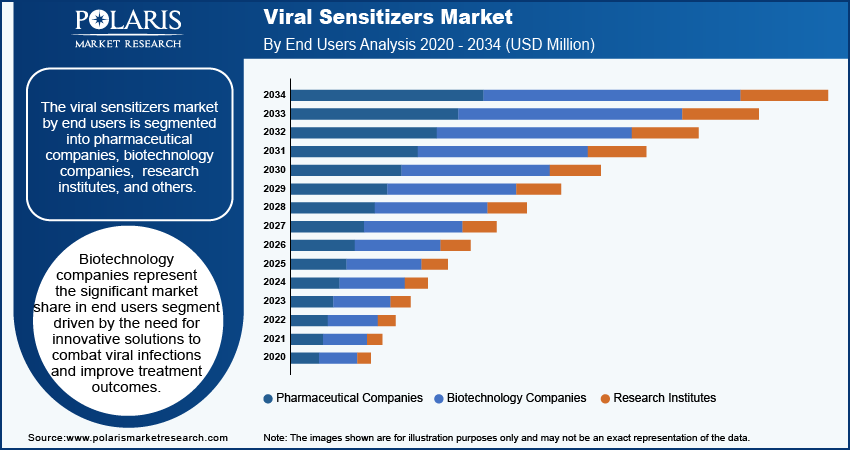
Viral Sensitizers Market Size, Share, Trends, Industry Analysis Report: By Application (Antiviral Drug Development, Vaccine Development, and Oncolytic Viral Therapies), End Users, and Region (North America, Europe, Asia Pacific, Latin America, and the Middle East & Africa) – Market Forecast, 2025–2034
- Published Date:Nov-2024
- Pages: 117
- Format: PDF
- Report ID: PM5231
- Base Year: 2024
- Historical Data: 2020-2023
Viral Sensitizers Market Overview
The viral sensitizers market size was valued at USD 2,033.24 million in 2024. The market is projected to grow from USD 2,326.63 million in 2025 to USD 7,950.80 million by 2034, exhibiting a CAGR of 14.6% from 2025 to 2034. The viral sensitizers market focuses on developing compounds that enhance the effectiveness of antiviral therapies by making viruses more susceptible to treatment. These sensitizers can improve the efficacy of existing antiviral drugs and assist in the development of new treatments. Key drivers of this market include the increasing prevalence of viral infections and the need for more effective therapeutic options. Additionally, advancements in drug delivery systems and personalized medicine are contributing to market growth. Emerging trends in the market are expected to focus on combination therapies and precision medicine approaches to tailor treatments to individual patient profiles, enhancing the overall effectiveness of antiviral strategies.

To Understand More About this Research: Request a Free Sample Report
Viral Sensitizers Market Trends and Drivers
Integration of Combination Therapies
A key trend anticipated in the viral sensitizers market is the integration of combination therapies. Combination therapies involve using viral sensitizers alongside antiviral drugs to enhance therapeutic outcomes. Studies have shown that combination therapies significantly improve treatment efficacy. For instance, a study published in Nature Reviews Drug Discovery (2022) demonstrated that combining viral sensitizers with existing antivirals led to a 35% increase in the overall effectiveness of the treatments against resistant strains of viruses. This trend is being driven by the need to overcome antiviral resistance and improve patient outcomes.
Advancements in Precision Medicine
Advancement in precision medicine is expected to be another significant trend in the viral sensitizers market. Precision medicine aims to tailor antiviral treatments based on individual patient profiles, including genetic information and specific viral strains. According to a report published in The Journal of Infectious Diseases in 2023, precision medicine strategies using viral sensitizers have shown up to a 40% improvement in treatment response rates compared to traditional methods. This trend reflects a growing emphasis on personalizing treatments to enhance their efficacy and reduce side effects.
Growing Focus on Novel Sensitizing Agents
The development of novel sensitizing agents is gaining momentum in the viral sensitizers market. Researchers are exploring new compounds that can effectively sensitize viruses to existing antiviral drugs. A recent study published in Antimicrobial Agents and Chemotherapy (2023) highlighted the discovery of several new viral sensitizers that have shown promise in preclinical trials, with the potential to significantly enhance the treatment of various viral infections. This trend underscores the continuous innovation and research aimed at expanding the arsenal of effective antiviral strategies.

Viral Sensitizers Market Segment Insights
Viral Sensitizers Market Breakdown by Application Insights
The viral sensitizers market by application is segmented into antiviral drug development, vaccine development, and oncolytic viral therapies. The antiviral drug development segment holds the largest market share and demonstrates the highest growth potential. This segment benefits from the increasing demand for effective antiviral treatments due to the rising prevalence of viral infections and the emergence of resistant viral strains. The use of viral sensitizers in antiviral drug development is crucial for enhancing the efficacy of existing therapies and for the creation of new drug candidates. Additionally, advancements in drug delivery systems and personalized medicine are further driving growth in this application segment.
The vaccine development segment also shows notable growth, driven by the ongoing efforts to improve vaccine efficacy against a range of viral pathogens. The integration of viral sensitizers into vaccine development processes aims to enhance immune responses and overcome challenges associated with viral mutations. Oncolytic viral therapies, while a smaller segment compared to antiviral drug development, are gaining traction due to their potential in cancer treatment, particularly through the use of viral sensitizers to boost the effectiveness of oncolytic viruses. Overall, the antiviral drug development segment leads in market share and growth, reflecting its central role in addressing the global need for more effective antiviral treatments.
Viral Sensitizers Market Breakdown by End Users Insights
The viral sensitizers market by end users is segmented into pharmaceutical companies, biotechnology companies, research institutes, and others. Biotechnology companies represent the significant market share in end users segment driven by the need for innovative solutions to combat viral infections and improve treatment outcomes. These companies are at the forefront of developing new antiviral drugs and therapies, making extensive use of viral sensitizers to enhance drug efficacy and address emerging viral threats. Their significant investment in research and development, along with their extensive resources, supports the dominant role of this segment in the market.
Research institutes also play a crucial role in the viral sensitizers market evaluation, particularly in the discovery and early-stage development of viral sensitizers. These institutions contribute to advancing scientific understanding and identifying potential new applications for viral sensitizers. While this segment is smaller compared to pharmaceutical and biotechnology companies, it is essential for generating foundational research and data that support further development in the industry. The others segment, which includes academic institutions and government agencies, represents a smaller portion of the market but is involved in supporting research and providing funding for various projects related to viral sensitizers.

Viral Sensitizers Market Breakdown by Regional Insights
By region, the study provides market insights into North America, Europe, Asia Pacific, Latin America, and the Middle East & Africa. In the regional analysis of the viral sensitizers market, North America holds the largest market share due to its advanced healthcare infrastructure, significant investment in biotechnology and pharmaceutical research, and a strong presence of key industry players. The region benefits from a high rate of research and development activities, substantial funding, and a robust pipeline of antiviral drug development. Additionally, North America's well-established regulatory framework and high prevalence of viral infections drive the demand for innovative antiviral treatments. This dominance is supported by the concentration of leading pharmaceutical and biotechnology companies, which are pivotal in advancing viral sensitizer technologies.
In Europe, the viral sensitizers market is characterized by strong research capabilities and a collaborative environment among academia, research institutes, and industry players. The region benefits from significant government funding and support for biotechnology innovations, which foster advancements in viral sensitizers. European countries with robust pharmaceutical sectors, such as Germany, the UK, and France, are key contributors to market growth, driven by their high levels of research activity and established healthcare systems. The increasing focus on combating emerging viral threats and the integration of viral sensitizers into therapeutic development are central to Europe market dynamics.
Asia Pacific is experiencing rapid growth in the viral sensitizers market, propelled by rising investments in biotechnology and pharmaceutical research. Countries such as China, Japan, and India are leading this growth due to their expanding healthcare infrastructure and increasing research output. The region’s large population base and the growing prevalence of viral infections create significant demand for effective antiviral treatments. Additionally, the viral sensitizers market in Asia Pacific benefits from increasing collaborations between local and international pharmaceutical companies, which enhance the development and distribution of viral sensitizers. The expanding clinical research activities and government initiatives to boost biotechnology innovation further contribute to the regional viral sensitizers market expansion.

Viral Sensitizers Market – Key Players and Competitive Insights
Key players in the viral sensitizers market include Gilead Sciences, Pfizer, Merck & Co., and Johnson & Johnson. These firms are actively involved in developing antiviral drugs and therapies that incorporate viral sensitizers. Other notable companies include AbbVie, Bristol-Myers Squibb, and Roche, which are engaged in innovative research and development efforts in this space. Additionally, biopharmaceutical firms such as Moderna, Novartis, and AstraZeneca are also key contributors to the viral sensitizers market, working on new sensitizers and treatment combinations. Smaller but significant players include Alnylam Pharmaceuticals, Iovance Biotherapeutics, and Cellectis, focusing on niche areas within viral sensitizers. Some companies, like the biotech firm Bluebird Bio, are under the acquisition umbrella of major entities like Bristol-Myers Squibb.
In terms of competitive dynamics, these companies vary in their approach to viral sensitizer development. Gilead Sciences and Merck & Co. are noted for their extensive pipelines and advanced clinical trials, often leading the introduction of novel compounds and therapies. Pfizer and Johnson & Johnson leverage their extensive resources and global reach to rapidly advance their research and development activities. Companies such as Moderna and Novartis are prominent for their cutting-edge research into new antiviral drugs and sensitizers, contributing significantly to the viral sensitizers market growth through innovation.
The competitive landscape is marked by a strong emphasis on collaborative efforts and partnerships. Many of the key players engage in joint ventures and research collaborations to accelerate the development of viral sensitizers. The focus on overcoming antiviral resistance and improving treatment efficacy drives much of the competition, with firms continually seeking to enhance their product offerings through strategic alliances and technological advancements. Overall, the market is characterized by a high level of activity and innovation, with companies striving to develop effective solutions to address viral infections and enhance therapeutic outcomes.
Gilead Sciences is a major player in the viral sensitizers market, known for its extensive research and development in antiviral therapies. The company is involved in developing innovative treatments that use viral sensitizers to enhance drug efficacy.
Pfizer is another significant company in the viral sensitizers market, actively engaged in the development of antiviral drugs and therapies. The company’s research includes exploring viral sensitizers to enhance the performance of existing antiviral treatments.
List of Key Companies in Viral Sensitizers Market
- Gilead Sciences
- Pfizer
- Merck & Co.
- Johnson & Johnson
- AbbVie
- Bristol-Myers Squibb
- Roche
- Moderna
- AstraZeneca
- Alnylam Pharmaceuticals
- Iovance Biotherapeutics
- Cellectis
- Bluebird Bio
- Regeneron Pharmaceuticals
Viral Sensitizers Industry Developments
- In August 2024, Pfizer highlighted a breakthrough in their research. It revealed positive results from a phase II clinical trial where a new viral sensitizer was combined with one of their antiviral drugs. According to Pfizer, this development marks a key advancement in its efforts to address challenges in treating viral infections and improving patient outcomes.
- In July 2024, Gilead Sciences announced a new clinical trial focusing on a combination therapy that integrates their proprietary antiviral agents with novel viral sensitizers. This move aims to improve the effectiveness of treatments for resistant viral strains, reflecting Gilead’s ongoing commitment to advancing antiviral solutions.
Viral Sensitizers Market Segmentation
By Application Outlook
- Antiviral Drug Development
- Vaccine Development
- Oncolytic Viral Therapies
By End Users Outlook
- Pharmaceutical Companies
- Biotechnology Companies
- Research Institutes
- Others
By Regional Outlook
- North America
- US
- Canada
- Europe
- Germany
- France
- UK
- Italy
- Spain
- Netherlands
- Russia
- Rest of Europe
- Asia Pacific
- China
- Japan
- India
- Malaysia
- South Korea
- Indonesia
- Australia
- Vietnam
- Rest of Asia Pacific
- Middle East & Africa
- Saudi Arabia
- UAE
- Israel
- South Africa
- Rest of the Middle East & Africa
- Latin America
- Mexico
- Brazil
- Argentina
- Rest of Latin America
Viral Sensitizers Market Report Scope
|
Report Attributes |
Details |
|
Market Size Value in 2024 |
USD 2,033.24 million |
|
Market Size Value in 2025 |
USD 2,326.63 million |
|
Revenue Forecast in 2034 |
USD 7,950.80 million |
|
CAGR |
14.6% from 2025 to 2034 |
|
Base Year |
2024 |
|
Historical Data |
2020–2023 |
|
Forecast Period |
2025–2034 |
|
Quantitative Units |
Revenue in USD million and CAGR from 2025 to 2034 |
|
Report Coverage |
Revenue Forecast, Market Competitive Landscape, Growth Factors, and Trends |
|
Segments Covered |
|
|
Regional Scope |
|
|
Competitive landscape |
|
|
Report Format |
|
|
Customization |
Report customization as per your requirements with respect to countries, regions, and segmentation. |
FAQ's
The viral sensitizers market size was valued at USD 2,033.24 million in 2024 and is projected to grow to USD 7,950.80 million by 2034.
The market is projected to register a CAGR of 14.6% from 2025 to 2034.
North America holds the largest share of the market.
Key players in the viral sensitizers market include Gilead Sciences, Pfizer, Merck & Co., and Johnson & Johnson. These firms are actively involved in developing antiviral drugs and therapies that incorporate viral sensitizers. Other notable companies include AbbVie, Bristol-Myers Squibb, and Roche, which are engaged in innovative research and development efforts in this space.
The antiviral drug development segment accounts for the largest share of the market.
The pharmaceutical companies segment accounted for the largest share of the market.
Viral sensitizers are compounds that enhance the susceptibility of viruses to antiviral treatments. They work by modifying viral or host cellular processes to make viruses more responsive to antiviral drugs. This can involve increasing the effectiveness of existing antiviral medications or enabling new therapies to work more efficiently. By sensitizing viruses, these compounds can help overcome issues like antiviral resistance and improve treatment outcomes for various viral infections.
A few key trends in the viral sensitizers market are described below: Integration of Combination Therapies: Combining viral sensitizers with existing antiviral drugs to improve treatment efficacy and address drug resistance. Advancements in Precision Medicine: Tailoring antiviral treatments based on individual patient profiles and specific viral strains to enhance effectiveness. Development of Novel Sensitizing Agents: Research into new compounds that can effectively sensitize viruses to existing antiviral therapies. Increased Focus on Drug Resistance: Addressing challenges related to antiviral resistance by using viral sensitizers to boost drug effectiveness. Growth in Emerging Markets: Expanding research and development efforts in regions with rising healthcare needs to address global viral infections.
A new company entering the viral sensitizers market should focus on several key areas to stay ahead of the competition. Emphasizing innovative research to develop novel sensitizing agents and exploring combination therapies can provide a competitive edge. Additionally, investing in precision medicine approaches to tailor treatments based on individual patient profiles could set the company apart. Building strategic partnerships with research institutions and leveraging emerging markets with growing healthcare needs will also enhance market positioning and foster growth.
Companies producing viral sensitizers and related products, healthcare providers, and other consulting firms must buy the report.
